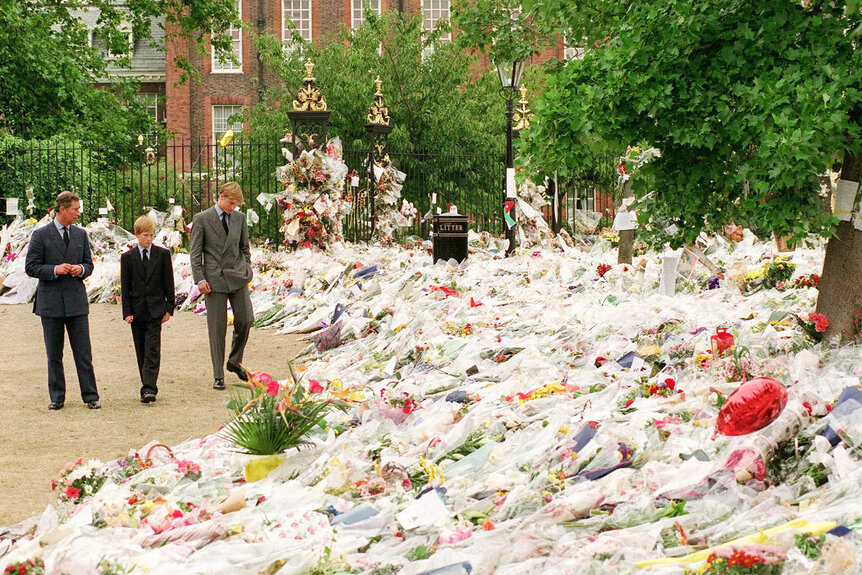Create a free profile to get unlimited access to exclusive videos, breaking news, sweepstakes, and more!
Were The Paparazzi Responsible For The Tragic 1997 Car Crash That Killed Princess Diana?
An inquest was opened to determine whether or not French paparazzi, as well as the reckless driving of Paul Henri, caused the car wreck that killed the Princess of Wales.

The shocking death of Diana, Princess of Wales, prompted international mourning and continues to be a source of fascination today.
Many can still recall hearing the news when Princess Diana was killed in a horrific car crash in Paris on Aug. 31, 1997, more than a quarter century ago. The 36-year-old — already the long-time subject of tabloid fodder for a number of reasons — left behind two young sons, Prince William and Prince Harry, then ages 15 and 12, whom she shared with her former husband, Prince Charles (now King Charles III).
Wanting answers, the world seemed to look for somewhere to place the blame. Years later, British jurors would be tasked with finding whether or not the paparazzi and the alleged reckless driving of chauffeur Henri Paul, 41, contributed to the crash that killed Diana and her male companion, Dodi Al Fayed, according to the Guardian. But would that be the case?
RELATED: ‘Banished’ Shines Light On ‘Completely Infantilized’ Prince Andrew
Before the shocking death, Diana was a fixture on the rag racks having married into the Royal Family in 1981. Much of this attention was due, in part, to Diana’s high sense of fashion and how every paparazzo seemed to capture her best angle. More importantly, her unorthodox approach to charity work with hundreds of organizations made her a folk hero both inside and outside the United Kingdom, earning her worldwide adoration.
But, this also placed her in the crosshairs of widespread media scrutiny, and she was regularly portrayed as bringing turbulence to the British Monarchy. Her marriage — which ended in 1996 — was a feeding frenzy for the papers, especially when, in 1995, Diana publicly sat down with the BBC and opened up about several highly-sensationalized issues, including her and her husband’s alleged extramarital affairs and her history of bulimia and depression.
Her death was no exception.
In the early morning hours of Aug. 31, 1997, Paul Henri — who worked as the Paris Ritz Hotel’s security director — was assigned as a chauffeur for Diana and her companion, Fayed, whose billionaire father, Mohamed Al Fayed, owned the hotel, according to the New York Times.
Earlier in the evening, dozens of French paparazzi interrupted Diana and Fayed’s attempts at a romantic dinner. The pair later planned to go to Fayed’s Paris apartment, while a decoy car was employed to help ward off photographers, according to the BBC. Diana and Fayed made their escape through the hotel’s back entrance.
Diana, Fayed, Henri and Diana’s bodyguard, Trever Rees-Jones, climbed into the Mercedes S280 at around 12:20 a.m. But the paparazzi were tipped off, and they caught up, prompting Henri to speed away from the hounding press.
At around 12:25 a.m., five minutes after leaving the Ritz, Henri crashed the car into the 13th pillar of the Post de I’Alma tunnel. According to the New York Times, investigators estimated he was driving 90 m.p.h. (about twice the speed limit) before losing control of the car, while some witnesses stated it was closer to 120 m.p.h., according to outlets such as the Associated Press and People.
Amidst the chaos, witnesses claimed the Mercedes struck a white Fiat just before the crash, though despite numerous inquiries, the owner of the vehicle was never conclusively identified.
Henri and Fayed died on the scene, and Rees-Jones would be the sole survivor, thanks to working airbags (he would contend for years that he had no memory of the event). It was additionally reported that none of the passengers were wearing seatbelts at the time of the crash, according to the Associated Press.
Paparazzi were reportedly on the scene within seconds, according to the BBC. This would provide an obstacle for first responders who tried to render aid to Diana, and eight photographers would be arrested and questioned about the accident.
However, Dr. Frederic Mailliez, agreeing that there were 10 to 15 photographers in the area, said they did not hinder his work, according to the Associated Press.
By 1:05 a.m., 40 minutes after the crash, Princess Diana had to be cut from the wreckage and was then whisked away via ambulance, though she had already suffered cardiac arrest, the BBC reported. On the way to Pitié-Salpétrière Hospital, EMTs stopped for five minutes to administer adrenaline to Diana’s body.
She finally arrived at the hospital, where doctors discovered she had torn a pulmonary vein, among other injuries, prompting medical professionals to surgically open her chest and maneuver hand compressions directly to her heart for nearly two hours, according to the BBC. However, the efforts were fruitless, and at 4:00 a.m., she was pronounced dead.
Fayed’s father was quick to declare his belief that his son and Diana were murdered, helping spark conspiracy theories around the world, according to the Guardian. The Harrod department store magnate would also attempt to pass the blame onto Diana’s former father-in-law, Prince Phillip, Queen Elizabeth II’s husband, and later requests by the grieving father for a joint inquest would be rejected.
A witness to the crash also reported seeing a “flash of light” just before the wreck, which also contributed to the abundance of unsubstantiated rumors, the BBC reported.
It was soon determined that Paul Henri's blood alcohol level was three times over the legal limit for alcohol, according to the BBC. Further testing revealed he was also on antidepressants, which could have been affected by alcohol consumption.
In the spring of 2002, the French Supreme Court concluded its investigation, declining to seek criminal charges against the paparazzi. However, in 2004, Royal Coroner Dr. Michael Burgess announced an inquest into the deaths of Diana and Fayed would be opened.
The findings would be submitted to the Royal Court of Justice in London in October 2007, after Dr. Burgess resigned in 2006, according to the BBC.
The inquest, dubbed Operation Paget, would last six months and included over 240 witnesses, costing more than £10 million (nearly $18 million today in US dollars), according to the Guardian. In the end, a jury found both Diana and Fayed were unlawfully killed due to Henri’s reckless driving and the paparazzi’s incessant chase.
Princes William and Harry personally thanked the jury, the coroner and most notably, Diana’s bodyguard, Trever Rees-Jones.
“Finally, the two of us would like to express our most profound gratitude to all those who fought so desperately to save our mother’s life on that tragic night,” a statement read, according to the Guardian. But because the UK had no jurisdiction to try French paparazzi, no one faced prosecution.
Royal Coroner Lord Justice Scott Baker said if tried in criminal court, the verdict would be the equivalent of manslaughter.
Mohamed Fayed stood firm in his belief that his son and Diana were murdered, claiming British intelligence agents “really know what happened,” according to the Guardian. In a 1999 interview with 60 Minutes Australia, he said the monarchy was behind the deaths because they didn’t want a Muslim man — his son — to be a stepfather to the princes.
The abbreviated life of Princess Diana continues to be felt around the world, most recently as the subject for the fifth season of Netflix’s critically-acclaimed dramatized series, “The Crown.”
Show writers have set the stage to depict the Princess of Wales’ shocking death in their sixth and final season, with filming already underway, according to People.
For many, news of Diana’s death can still be remembered in the way many recall some of the world’s greatest tragedies.


























